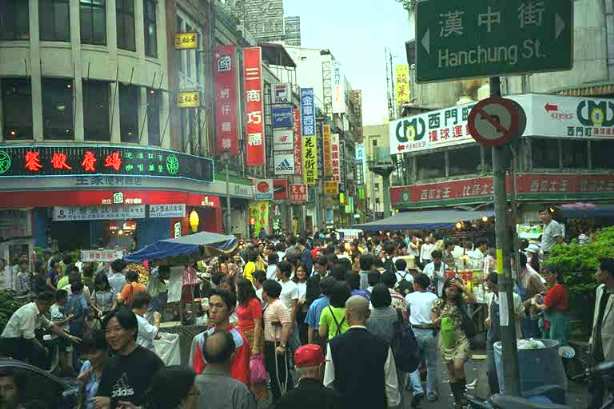
Not really representative of where I'm staying, but the photo does capture the general feeling once you start walking around Taipei. From a German Taipei site.
I'll be in Taiwan for a week or so starting today, visiting family and reacquainting myself with the country. The last visit was nearly 5 years ago, and back then, the government had just embarked on a national greenspaces plan; driving around, it felt like every piece of land near some kind of new road had a pre-development billboard on it, advertising condos not yet built; and Taipei's subway and lightrail transit system just opened. I'm looking forward to seeing how things have changed since.
2.19.2006
In Taiwan
Posted by Shin-pei at 6:52 PM 0 comments
2.15.2006
Our lives, our health, our places
I just love this article, published in the NYT health section - personal health, to be exact. Now if only the NYT would start getting its design criticism to mesh more with its health and city writers. This should be a national agenda. Here it is, in its entirety so you're not blocked by the web site.
February 14, 2006
Personal Health
Time to Get Out, for the Body and the Mind
By JANE E. BRODY
After spending a weekend in the country, my grandson Stefan, then 5, remarked: "The good thing about the country is you can go pee-pee outside. The bad thing about the country is you have to drive everywhere."
Spoken like a true city boy, born and bred, who with his twin brother, Tomas, is used to getting from place to place on foot, on scooter, on bicycle, on a bus or train, but rarely in a car. But in the country, as in most suburbs of the United States, it's "get in the car" to go to the grocery store, the drugstore, the playground, the soccer field, the Y, even to the house next door.
"Kids today are better at running a software program than running a mile," said Mark Dessauer, communications director of Active Living by Design. "They have stronger thumbs than legs." Active Living is a national program to promote increased activity among people of all ages.
Thanks to the post-World War II building boom, driven by a surge in car ownership, the need for housing for returning G.I.'s and government-subsidized road building, America spread out and systematically programmed itself into a motor-driven sedentary society that is now taking a serious toll on the nation's health.
A 1995 study by the Transportation Department of found that children's nonmotorized trips to school had declined 40 percent in the previous 20 years and that adults' trips on foot dropped 42 percent in that same period. One-quarter of all trips are a mile or shorter, yet three-fourths of them are made by car. Not surprising, the number of vehicle miles traveled rose 250 percent from 1960 to 1997. With an increasing focus on roads to accommodate sprawl, sidewalks and protected crossings were often forgotten so that even people willing to walk could not do so safely.
Restoring Person Power
One major result of this failure to use "person power" is that children and adults today are fatter than ever. Diabetes rates are soaring, and an increase in hypertension and heart disease cannot be far behind. Furthermore, mounting evidence suggests that a sedentary life is bad for emotional and cognitive well-being. Then there is the pollution from motor vehicles and the stress associated with long and congested commutes that take an additional toll on health.
Currently, just a minority of Americans achieve the minimum recommended amount of physical activity — 30 minutes a day at least 5 days a week — and 60 percent get no exercise.
Impediments include lack of time (especially when hours a day are spent commuting), unsafe neighborhoods and, perhaps most important of all, no convenient and enticing place to be active.
Congress has not helped matters. Several years ago, it voted to increase financing for highways but against more money for bike lanes.
It is time to make changes, in what planners call the "built environment," to give more people the opportunity to become physically active and remain so. "It's not just a question of health. It's also quality of life," Mr. Dessauer said. "Can I walk to the store, bike to the park, see my neighbors out on the street?"
The Robert Wood Johnson Foundation is underwriting the $15.5 million active-living program in 25 communities to test the widely held belief that making the built environment friendlier to pedestrians and cyclists will encourage more people to become active and increase activity among those now less-than-optimally active.
Each of the 25 communities (of the 963 that applied) has received a five-year grant of $200,000 to create partnerships of programs, promotions, policy changes and physical projects like sidewalks, bike lanes and racks, speed bumps and striped crossings aimed at making the community safer and more accessible to those willing to use their feet.
The philosophy is that a holistic approach, not just education, is needed to change people's behavior. One such project is under way at the site of Denver's old Stapleton Airport that will eventually be five town centers with 30,000 residents, 35,000 jobs and 2 square miles of city parks.
The 1,500 residents of the first finished neighborhood can walk to two parks; a swimming pool; an elementary school; and a town center with a grocery store, drugstore and restaurants, as well as bus service. The sidewalks, narrow streets, parkways and greenways are links to 150 miles of Denver trails.
Chapel Hill, N.C., the base of Active Living by Design, is another test case. There, a mile from the University of North Carolina, a community called Carolina North is being developed.
A combination of homes, stores, parks and playgrounds will result in a "mixed-use community of pedestrian-friendly neighborhoods well connected to Chapel Hill's network of sidewalks and bus routes," the planners say.
In still another project in the South Bronx, a part of the Sheridan Expressway will become a greenway where people can walk, bike and plant gardens. "We're not anticar; we're pro-choice," Mr. Dessauer said. "People should have the option to walk and bike, as well as drive."
Even without the support of a major foundation, communities and individuals can do much to promote healthful activities among their fellow residents. Mr. Dessauer suggested supporting bond measures to establish or extend trails where people can walk and bike. When new housing developments are proposed, zoning requirements should include building sidewalks and safe play areas. Cluster housing, leaving a large community-accessible area in the middle, is a concept gaining acceptance in many areas.
Making Your Next Move
When moving to a new home, consider whether the neighborhood has sidewalks and how close the home is to shopping, schools, parks or exercise centers. Can children walk or bike to school? Is there a trail or park or playground nearby where you or your children can run around and play and get the 30 minutes a day of moderately intense activity that can preserve health?
Is the neighborhood safe and accessible for older adults who may not have cars or may be too old to drive?
If possible, support programs like Rails to Trails, which establishes walking and biking trails all over the country on unused railroad tracks. These trails, found in many urban, suburban and rural areas, often pass through some of the most beautiful countryside.
Encourage transportation authorities to establish bike paths, install traffic lights, create pedestrian islands and hatched crossings and close neighborhood boulevards to traffic on weekends.
Get children involved in fostering active programs, perhaps through fund-raising (though, please, not selling candy), selling raffles or distributing fliers. If possible, volunteer to be a parent chaperon from time to time so that children can be taken to activity areas beyond the school and become better acquainted with what's available in the neighborhood.
The bottom line? Being healthy is not just a matter of avoiding illness. It also means feeling strong and vibrant, able to walk up stairs, carry a child or bag of groceries and otherwise perform life's activities without becoming breathless or exhausted, no matter what your age.
Posted by Shin-pei at 12:00 PM 0 comments
2.14.2006
About Wal-Mart, by a small business owner
A truly thoughtful account of Wal-Mart's impact on one small town in Wyoming, written by the daughter of a small business owner. No ribald bashing, simply what happened. Scroll down for the interesting discussion.
Posted by Shin-pei at 10:54 PM 0 comments
Belated snow
I'm incredibly late on posting: The blizzard has come and gone into slushy mush, and by all accounts, the phrase "the best time to experience New York is during a snow storm" is verging on cliche. It was great that so many people were out to enjoy the snow.
We went sledding in Central Park, a repeat of what we did during last year's big snow storm. I love that the Parks Department prepares by putting out bales of hay at the foot of any large hill, in anticipation of sledders. Sledding is really the only time in the city when sharing a rare commodity - a good sled - is de riguer and knocking people head over heels is appropriate -- nay, expected! I didn't take any pictures myself, but from the numerous flashes that were going off in the gloaming, I couldn't wait to see what was posted. Here's a few of the best off of Flickr.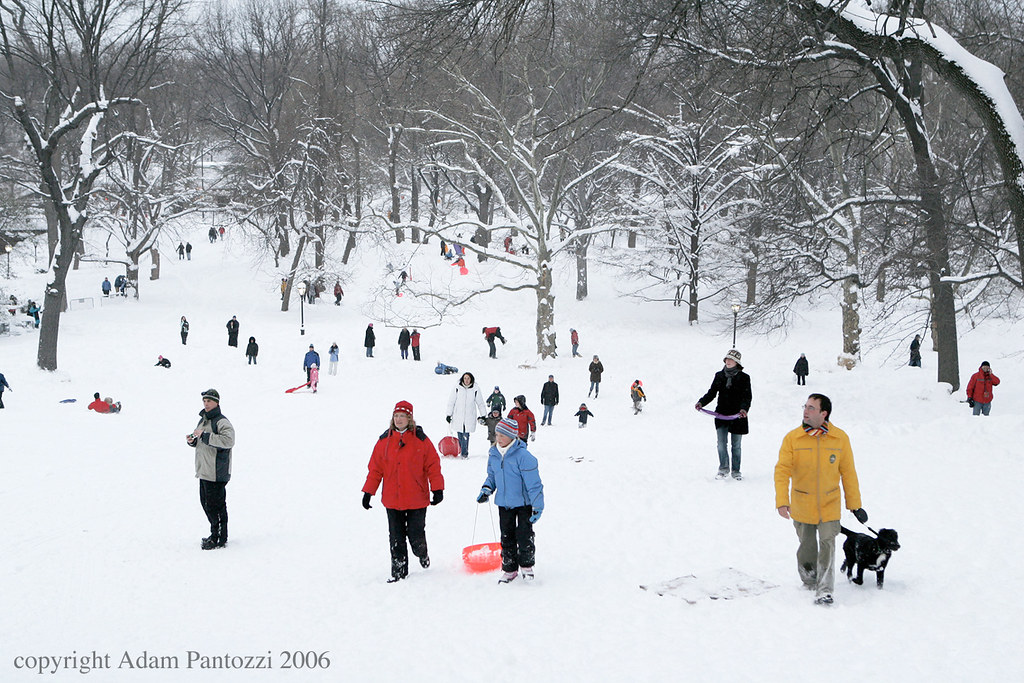
by Adam Pantozzi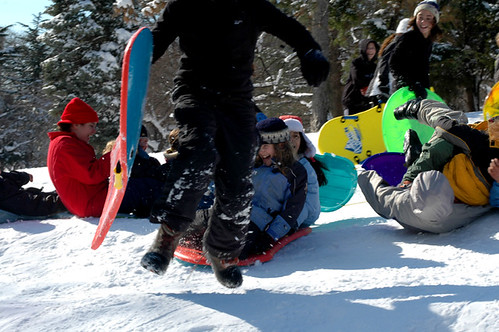
from drewbic gallery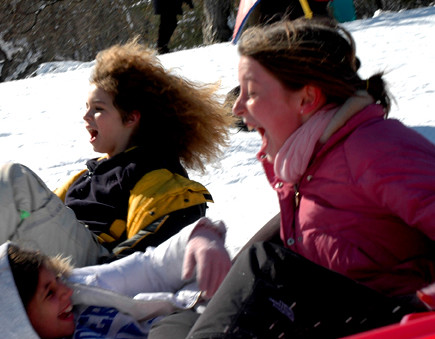
Another from drewbic gallery. Watch out!!!
Posted by Shin-pei at 10:36 PM 0 comments
2.10.2006
On target - Spanish architecture

Morphosis Housing Complex, Madrid, Spain
I went to a preview of the new exhibit of modern Spanish architecture at the Moma this week (the page has a good audio tour explaining the rationale behind the selection). I love how daring Spanish architecture has been of late. It appears in my mind's eye as colorful and whimsical. I was also really excited to see the Moma without the weekend crowds. I personally love people in the building, but many people don't and some have issues with the building layout itself.
The exhibit itself was really fun. The buildings were shown at a few different scales to provide profiles up close and from afar.
The architecture was fascinating, yet were not always the most colorful, whimsical or livable designs. There were plenty of buildings that looked beautiful from about the second story up, but unfortunately were pretty blank and non-descript at ground level. As a pedestrian, it wouldn't be something I would want to walk next to or live next to, though looking at models from that seemingly standard architecture/art model height of about 50 feet taller than the height of the building, many of the buildinsg showcased looked magnificent and forward.
Has beauty been divorced from function in the architecture world? Only 18 of the 35 buildings showcased were complete - the proof is in the pudding. I would love to visit these buildings and see if impressions based on the models are accurate.
Posted by Shin-pei at 6:06 PM 3 comments
2.09.2006
Living Streets

An "after" pic depicting the beautiful potential of Astor Place
If you missed the Livable Streets gala this past week, the exhibit will still be up at the Municipal Art Society's Urban Center through March.
Here's a trailer of what the exhibit is all about.
Posted by Shin-pei at 7:29 PM 0 comments
2.08.2006
Homage to Jane Jacobs
...and some good post-war "urban renewal" history too. A very nice way of getting introduced to Jane Jacobs.
2blowhards's Jane Jacobs via curbed.
Posted by Shin-pei at 10:12 AM 0 comments
2.07.2006
Street Foodies Unite!
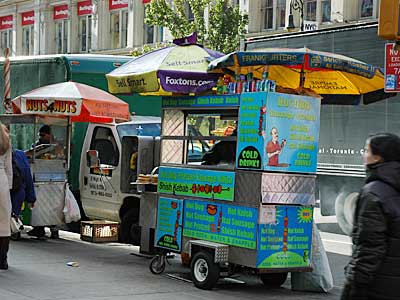
Image from urban75
This has been posted and sent around, but just for my reference, I also wanted to give some space to Platial. It was noted initially for its ability to generate a street food map (I suppose I should submit the obvious oversight of the Dosa Guy in Washington Square Park), but I like that it is simply a democratic way for people to mark their favorite vernacular places. All Google Maps carry an element of that, but the purpose behind the site says more. I like that it does so in a sensible way, less W. Benjamin-y than glowlab, though I like that technique too.
I for one can't wait until someone with enough time and energy and tech know-how maps these great places, since the descriptions that people send in are so fun.
Posted by Shin-pei at 6:18 PM 0 comments
Round-up on Detroit
There's a report card of sorts on how Detroit fared with hosting the Super Bowl. Did it hit its economic goals? Check out Detroit Free Press to find out.
And for another bout, of a completely different sort, Richard Layman, a native Detroiter, offers thoughts on Detroit, and picks up a couple of things from Seattle, here, here and in general, if you couldn't tell, he's extremely prolific and brings in thoughts on Detroit in many posts. I confess I can't always keep up, but it's always an interesting read.
Posted by Shin-pei at 11:00 AM 2 comments